The Historical and Future Variations of Water Conservation in the Three-River Source Region (TRSR) Based on the Soil and Water Assessment Tool Model
Abstract
:1. Introduction
2. Materials and Methods
2.1. Region
2.2. Data
- (1)
- SSP1-1.9 (SSP119): Sustainable development path
- (2)
- SSP2-4.5 (SSP245): Medium development path
- (3)
- SSP5-8.5 (SSP585): High economic growth path
2.3. SWAT Model
2.4. Calibration Method
2.5. Evaluation Indicator
3. Results
3.1. Model Optimization and Validation
3.2. Spatiotemporal Variations of Water Conservation in the Three Regions(YR, YZ, and LCJ) from 1981 to 2014
3.2.1. Temporal Variation
3.2.2. Spatial Variation
3.2.3. Correlation Analysis between Meteorological and Hydrological Elements and Water Conservation
3.3. Temporal and Spatial Changes in Water Conservation in TRSR in the Future
3.3.1. SSP1-1.9 (SSP119) Scenario
3.3.2. SSP2-4.5 (SSP245) Scenario
3.3.3. SSP5-8.5 (SSP585) Scenarios
4. Discussion
4.1. The Consistency of Runoff Simulaiton with the References
4.2. Some Physical Explainations on the Past Water Conservation Changes in the TRSR
4.3. Some Suggestions or Measures to Deal with the Future Water Conservation Changes in Different Emission Scenarios
5. Conclusions
- (1)
- By calibrating and validating the runoff simulation results of the SWAT model in the TRSR, it was found that both the R2 and NSE values of the SWAT model exceeded 0.78 in the calibration period and the validation period, which indicates that the model has good applicability in the TRSR.
- (2)
- During the period of 1981–2014, the overall water conservation capacity and water conservation coefficient of the TRSR showed upward trends. However, different sub-regions behaved differently. For instance, the water source capacities of the YTZ and LC showed upward trends, while the water source capacity of the YL showed a significant decrease. In terms of spatial distribution, the southeastern part of the YR had the highest water conservation capacity, but its growth rate was not high; it even slightly decreased. The western part of the YZ had the lowest water conservation capacity, but its growth rate was the highest. Moreover, the spatial change trend of the water conservation capacity was basically consistent with that of the water conservation coefficient in the TRSR, indicating that both of them had favorable consistency in the TRSR.
- (3)
- In different emission scenarios for the future, the water conservation capacity and water conservation coefficient of the TRSR showed different changes. In the SSP119 scenario, the water conservation capacity and water conservation coefficient of the TRSR and its three sub-regions showed an initial decreasing trend and then an increasing trend. In the SSP245 scenario, the water conservation capacity and water conservation coefficient of the TRSR and its three sub-regions first showed an upward trend and then a downward trend. In the SSP585 scenario, the trends of water conservation capacity and water conservation coefficient in the TRSR and its three sub-regions were significantly higher, with the most obvious increase being in the long-term, when the growth slope of water conservation reached about 5 mm/year, which is 10 times that of the near-term and 3~5 times that of the mid-term. The growth rate of water conservation coefficient was about 0.006/year in the long-term, which was 5–6 times that of the near- and mid-terms, while the growth rates in the mid- and long-terms were basically the same. For the different scenarios, the different measures should be adopted to protect the water conservation and the sustainable ecological development in the TRSR.
Author Contributions
Funding
Institutional Review Board Statement
Informed Consent Statement
Data Availability Statement
Conflicts of Interest
References
- Vörösmarty, C.J.; Green, P.; Salisbury, J.; Lammers, R.B. Global Water Resources: Vulnerability from Climate Change and Population Growth. Science 2000, 289, 284–288. [Google Scholar] [CrossRef] [PubMed]
- Sun, L.; Zhu, J. Comprehensive Benefit Study and Evaluation of Soil and Water Conservation Forest System; China Science and Technology Press: Beijing, China, 1995. [Google Scholar]
- Zhang, B.; Li, W.; Xie, G.; Xiao, Y. Water conservation function and its measurement methods of forest ecosystem. Chin. J. Ecol. 2009, 28, 529–534. (In Chinese) [Google Scholar]
- Deng, K.; Shi, P.; Xie, G. Water conservation of forest ecosystem in the upper reaches of yangtze river and its benefits. Resour. Sci. 2002, 24, 68–73. (In Chinese) [Google Scholar]
- Wei, C. Assessment and Comparative Study on the Changes of Water Conservation Function in Songjiang and Baihe Small Watersheds; Northeast Normal University: Changchun, China, 2021; (In Chinese). [Google Scholar] [CrossRef]
- Wang, Y.; Ye, A.; Qiao, F.; Li, Z.; Miao, C.; Di, Z.; Gong, W. Overview of the connotation and estimation methods of water conservation function. South-North Water Transf. Water Sci. Technol. 2021, 19, 1041–1071. [Google Scholar] [CrossRef]
- Akoko, G.; Le, T.H.; Gomi, T.; Kato, T. A review of SWAT model application in Africa. Water 2021, 13, 1313. [Google Scholar] [CrossRef]
- Shrestha, S.; Shrestha, M.; Shrestha, P.K. Evaluation of the SWAT model performance for simulating river discharge in the Himalayan and tropical basins of Asia. Hydrol. Res. 2018, 49, 846–860. [Google Scholar] [CrossRef]
- Sok, T.; Oeurng, C.; Ich, I.; Sauvage, S.; Miguel Sánchez-Pérez, J. Assessment of hydrology and sediment yield in the Mekong river basin using SWAT model. Water 2020, 12, 3503. [Google Scholar] [CrossRef]
- Martínez-Salvador, A.; Millares, A.; Eekhout, J.P.C.; Conesa-García, C. Assessment of streamflow from EURO-CORDEX regional climate simulations in semi-Arid catchments using the SWAT model. Sustainability 2021, 13, 7120. [Google Scholar] [CrossRef]
- Abbaspour, K.C.; Rouholahnejad, E.; Vaghefi, S.A.; Srinivasan, R.; Yang, H.; Kløve, B. A continental-scale hydrology and water quality model for Europe: Calibration and uncertainty of a high-resolution large-scale SWAT model. J. Hydrol. 2015, 524, 733–752. [Google Scholar] [CrossRef]
- Chien, H.; Yeh, P.J.; Knouft, J.H. Modeling the potential impacts of climate change on streamflow in agricultural watersheds of the Midwestern United States. J. Hydrol. 2013, 491, 73–88. [Google Scholar] [CrossRef]
- Chen, Y.; Feng, Q.; Wang, K. Research on the impact of pollution control measures on the improvement of Mangxi River water quality based on SWAT model. Sichuan Environ. 2024, 43, 24–31. (In Chinese) [Google Scholar] [CrossRef]
- Tai, L.; Rao, W.; Tan, T.; Tan, H.; Jiang, S.; Zhang, X. Scenario simulation study of hydrological characteristics in the Golmud river basin based on SWAT model. J. China Hydrol. 2023, 43, 46–51. (In Chinese) [Google Scholar] [CrossRef]
- Ma, X.; Wu, T.; Yu, Y. A study of runoff scenario prediction in the upper reaches of Hanjiang River based on SWAT model. Remote Sens. Nat. Resour. 2021, 1, 174–182. (In Chinese) [Google Scholar] [CrossRef]
- Zhou, D. Study on the Response of Runoff in the Upper Minjiang River Basin to Land Use and Climate Change over the Past 40 Years; Sichuan Agricultural University: Ya’an, China, 2019; (In Chinese). [Google Scholar] [CrossRef]
- Guo, W. Study on the Temporal and Spatial Variation of Nitrogen and Phosphorus Non-Point Source Pollution in Farmland Based on SWAT Model; North China University of Water Resources and Electric Power: Zhengzhou, China, 2019. [Google Scholar]
- Zhao, L. Simulation Study on Runoff and Sediment Yield in the Upstream of Huangqian Reservoir Based on SWAT Model; Shandong Agricultural University: Tai’an, China, 2022. [Google Scholar]
- Liu, Y.; Wang, W.; Liu, Y.; Cui, W. Data assimilation experiment of soil moisture based on EnKF method and SWAT model. Eng. J. Wuhan Univ. 2024, 57, 17–27. [Google Scholar] [CrossRef]
- Chen, Y.; Marek, G.W.; Marek, T.H.; Porter, D.O.; Brauer, D.K. Simulating the effects of agricultural production practices on water conservation and crop yields using an improved SWAT model in the Texas High Plains, USA. Agric. Water Manag. 2021, 244, 106574. [Google Scholar] [CrossRef]
- Li, C.; Zhang, X.; Wu, Y.; Hao, F.; Yin, G. Landscape pattern change of the ecological barrier zone in Beijing-Tianjin-Hebei region and its impact on water conservation. China Environ. Sci. 2019, 39, 2588–2595. (In Chinese) [Google Scholar]
- Lin, F.; Chen, X.; Yao, W.; Fang, Y.; Deng, H.; Wu, J.; Liu, B. Multi-time scale analysis of water conservation in a discontinuous forest watershed based on SWAT model. Acta Geogr. Sin. 2020, 75, 1065–1078. (In Chinese) [Google Scholar] [CrossRef]
- Li, M.; Di, Z.; Yao, Y.; Ma, Q. Variations in water conservation function and attributions in the Three-River Source Region of the Qinghai–Tibet Plateau based on the SWAT model. Agric. For. Meteorol. 2024, 349, 109956. [Google Scholar] [CrossRef]
- IPCC. 2023: Sections. In Climate Change 2023: Synthesis Report. Contribution of Working Groups I, II and III to the Sixth Assessment Report of the Intergovernmental Panel on Climate Change; Core Writing Team, Lee, H., Romero, J., Eds.; IPCC: Geneva, Switzerland, 2023; pp. 35–115. [Google Scholar] [CrossRef]
- Jensen, M.E.; Burman, R.D.; Allen, R.G. Evapotranspiration and Irrigation Water Requirements; American Society of Civil Engineers: New York, NY, USA, 1990; 360p. [Google Scholar]
- Priestley, C.H.B.; Taylor, R.J. On the assessment of surface heat flux and evaporation using large-scale parameters. Mon. Weather Rev. 1972, 100, 81–92. [Google Scholar] [CrossRef]
- Hargreaves, G.L.; Hargreaves, G.H.; Riley, J.P. Agricultural benefits for Senegal River Basin. J. Irrig. Drain. Eng. 1985, 111, 113–124. [Google Scholar] [CrossRef]
- Grusson, Y.G.; Sun, X.L.; Gascoin, S.; Sauvage, S.; Raghavan, S.; Anctil, F.; Sáchez-Pérez, J.M. Assessing the capability of the SWAT model to simulate snow, snow melt and streamflow dynamics over an alpine watershed. J. Hydrol. 2015, 531, 574–588. [Google Scholar] [CrossRef]
- Song, Z.; Zeng, J.; Jin, Y.; Hu, X.; Sun, D.; Lu, S.; Zhang, Y. Distributed simulation of monthly runoff using SWAT and SUFI-2 algorithm in Shiyang river basin. J. Soil Water Conserv. 2016, 36, 172–177. (In Chinese) [Google Scholar] [CrossRef]
- Liu, Y.; Lu, Y.; Zhou, Q.; Li, C. Application of HBV model to the study on risk precipitation in different grades in Batang river region. Res. Soil Water Conserv. 2015, 22, 5. (In Chinese) [Google Scholar] [CrossRef]
- Zhang, X.; Srinivasan, R.; Debele, B.; Hao, F. Runoff simulation of the headwaters of the Yellow River using the SWAT model with three snowmelt algorithms. J. Am. Water Resour. AS. 2008, 44, 48–61. [Google Scholar] [CrossRef]
- Zhang, Y.; Zhang, S.; Xia, J.; Dong, H. Temporal and spatial variation of the main water balance components in the three rivers source region, China from 1960 to 2000. Environ. Earth Sci. 2013, 68, 973–983. [Google Scholar] [CrossRef]
- Li, X.; Jia, H.; Chen, Y.; Wen, J. Runoff simulation and projection in the source area of the Yellow River using the SWAT model and SSPs scenarios. Front. Environ. Sci. 2022, 10, 1012838. [Google Scholar] [CrossRef]
- Liu, W.; Xu, Z.; Li, F.; Zhang, L.; Zhao, J.; Yang, H. Impacts of climate change on hydrological processes in the Tibetan Plateau: A case study in the Lhasa River basin. J. Am. Water Resour. Assoc. 2015, 29, 1809–1822. [Google Scholar] [CrossRef]
- Zhang, Y.; Zhang, S.; Zhai, X.; Xia, J. Runoff variation and its response to climate change in the Three Rivers Source Region. J. Geogr. Sci. 2012, 22, 781–794. [Google Scholar] [CrossRef]
- Zhang, F.; Yang, L.; Wang, C.; Zhang, C.; Wan, J. Distribution and conservation of plants in the northeastern Qinghai–Tibet Plateau under climate change. Diversity 2022, 14, 956. [Google Scholar] [CrossRef]
- He, Q.; Kuang, X.; Ma, E.; Chen, J.; Feng, Y.; Zheng, C. Evolution of runoff components and groundwater discharge under rapid climate warming: Lhasa river basin, Tibetan Plateau. J. Hydrol. 2024, 628, 130556. [Google Scholar] [CrossRef]
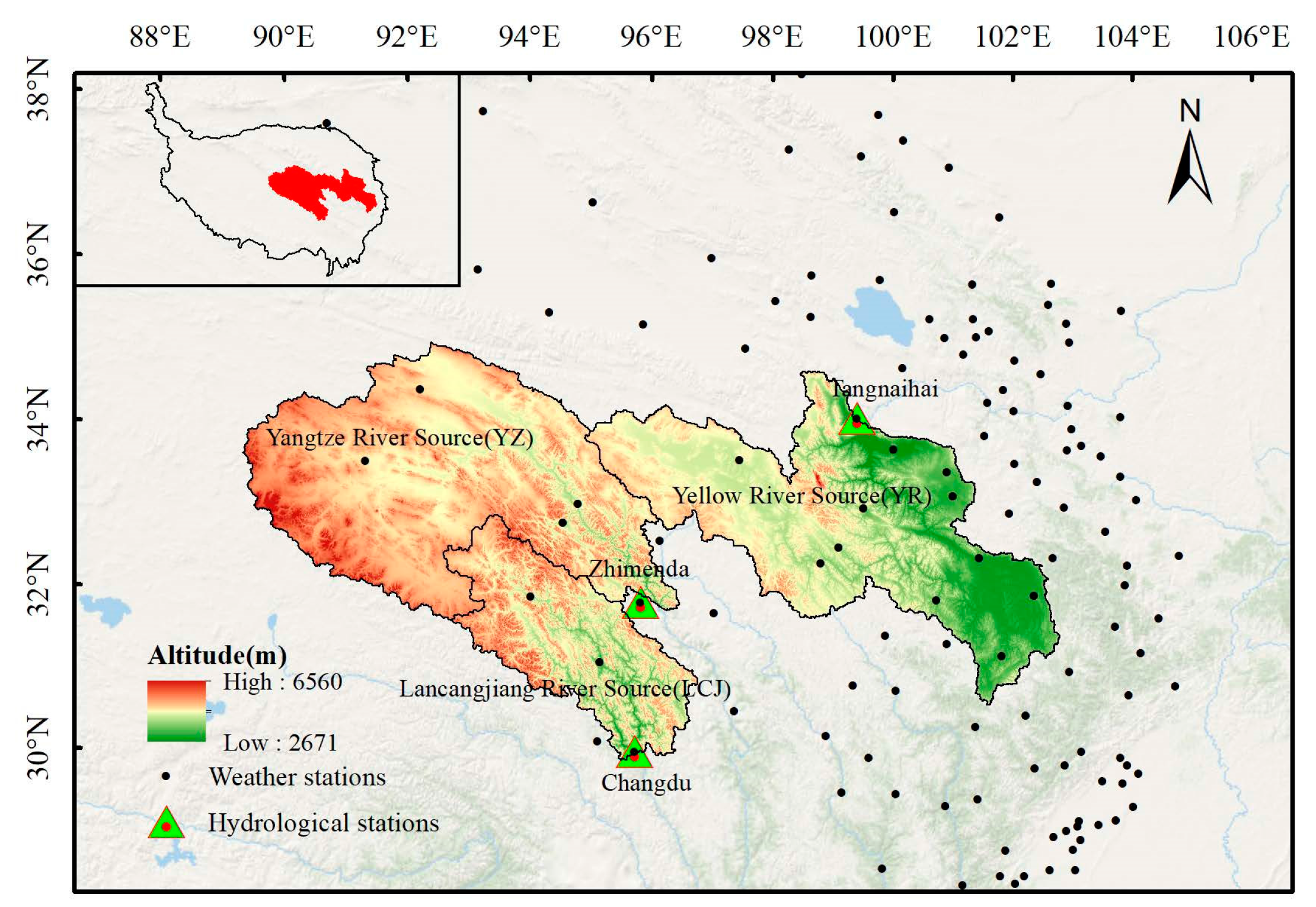
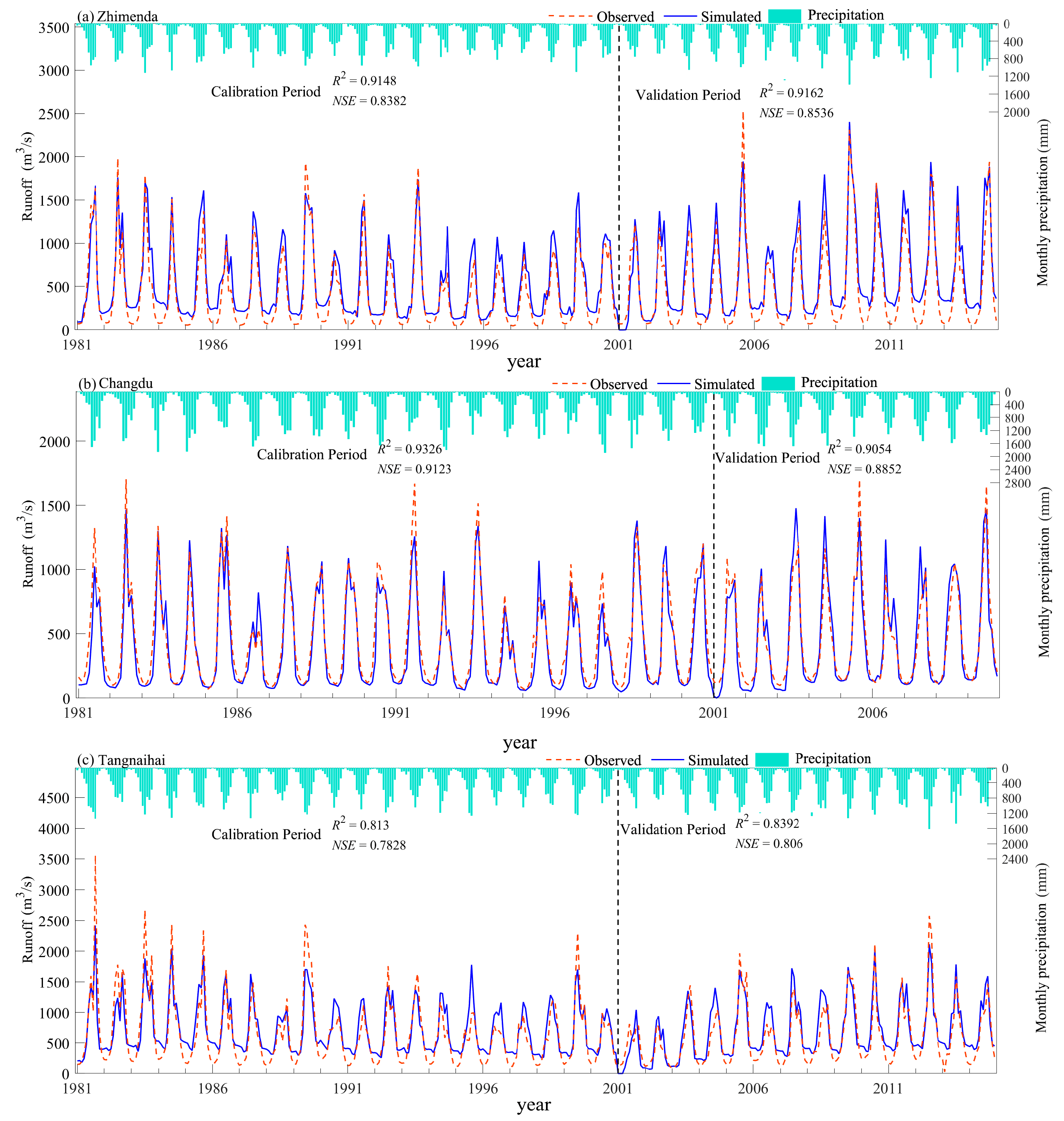
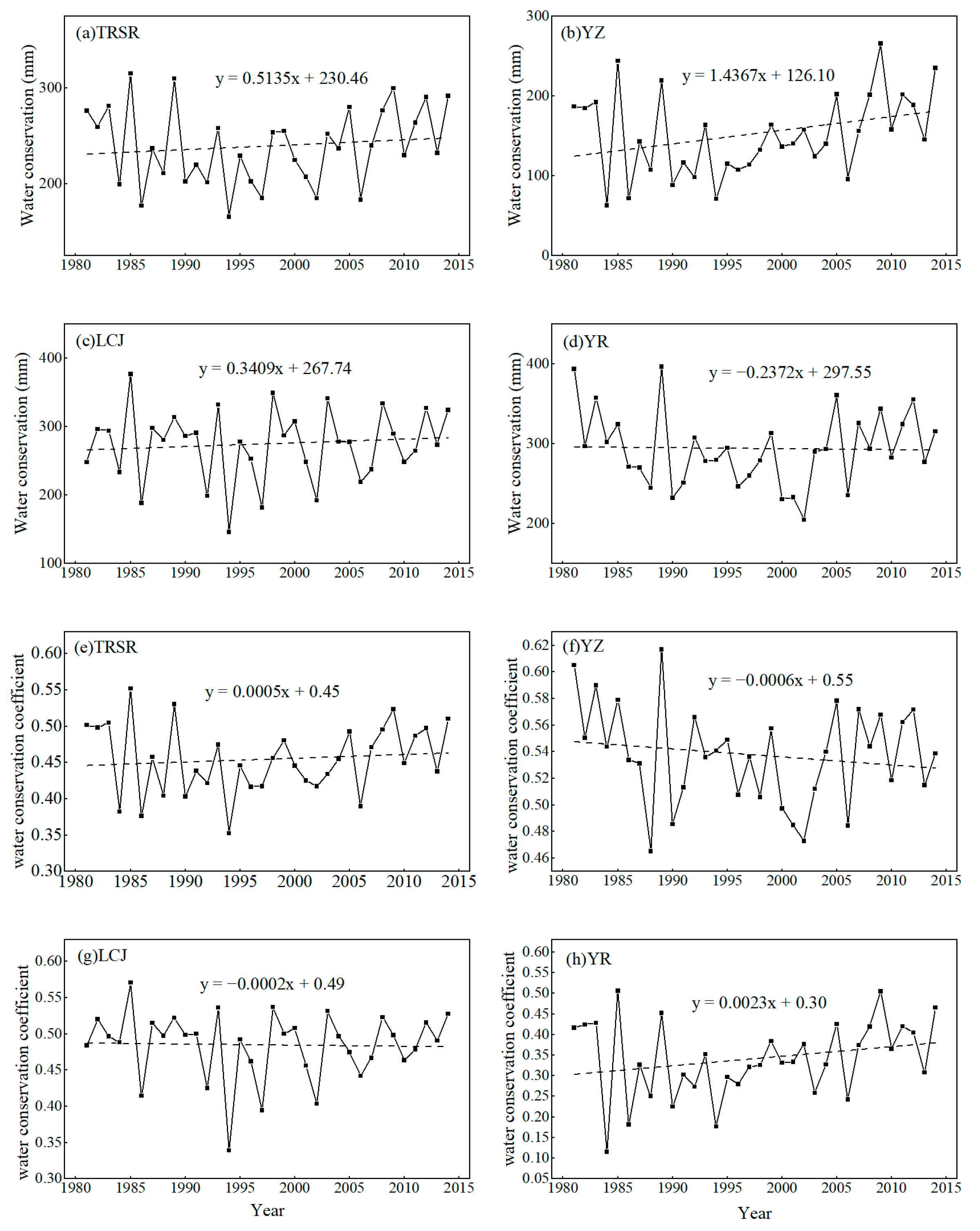
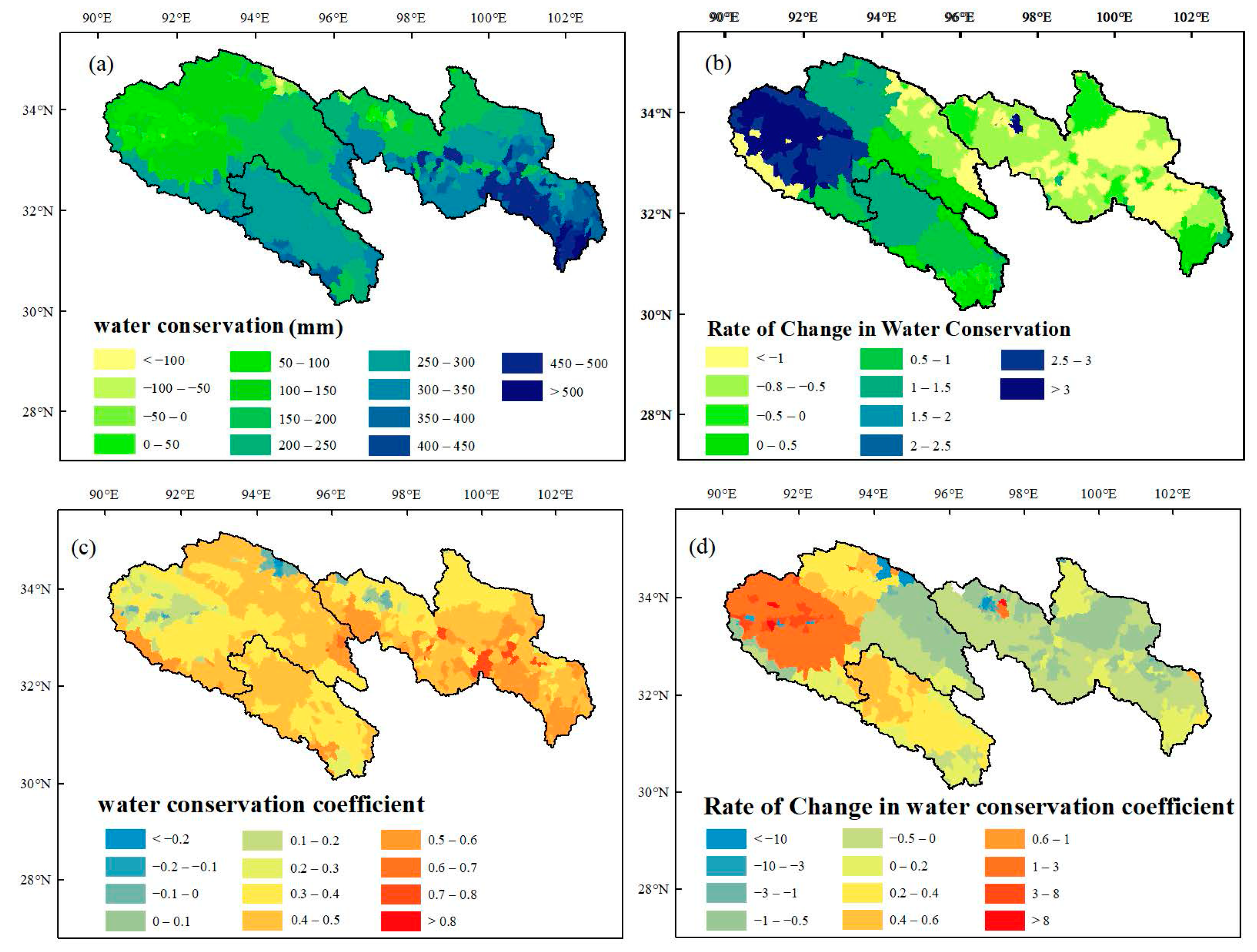
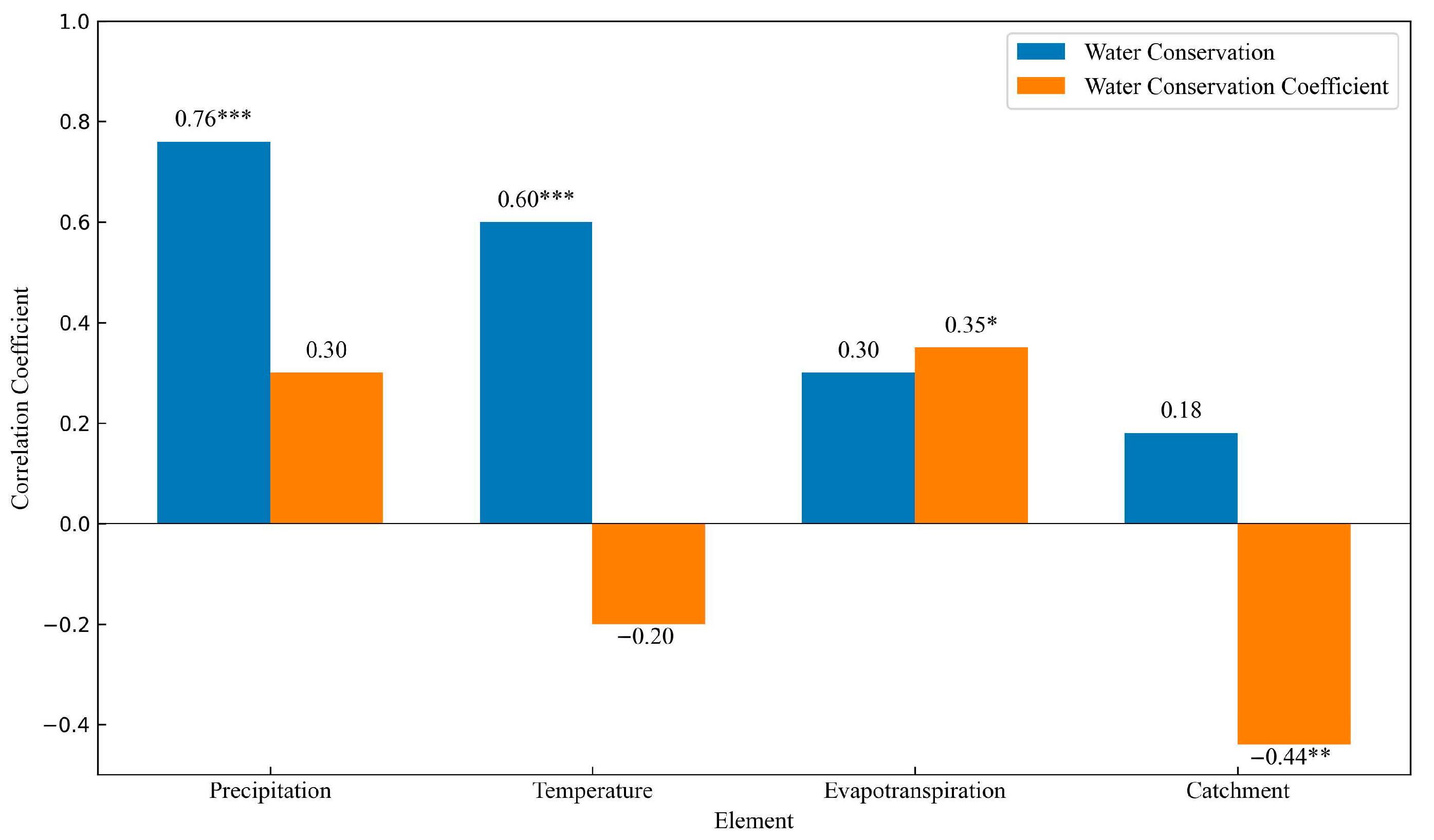
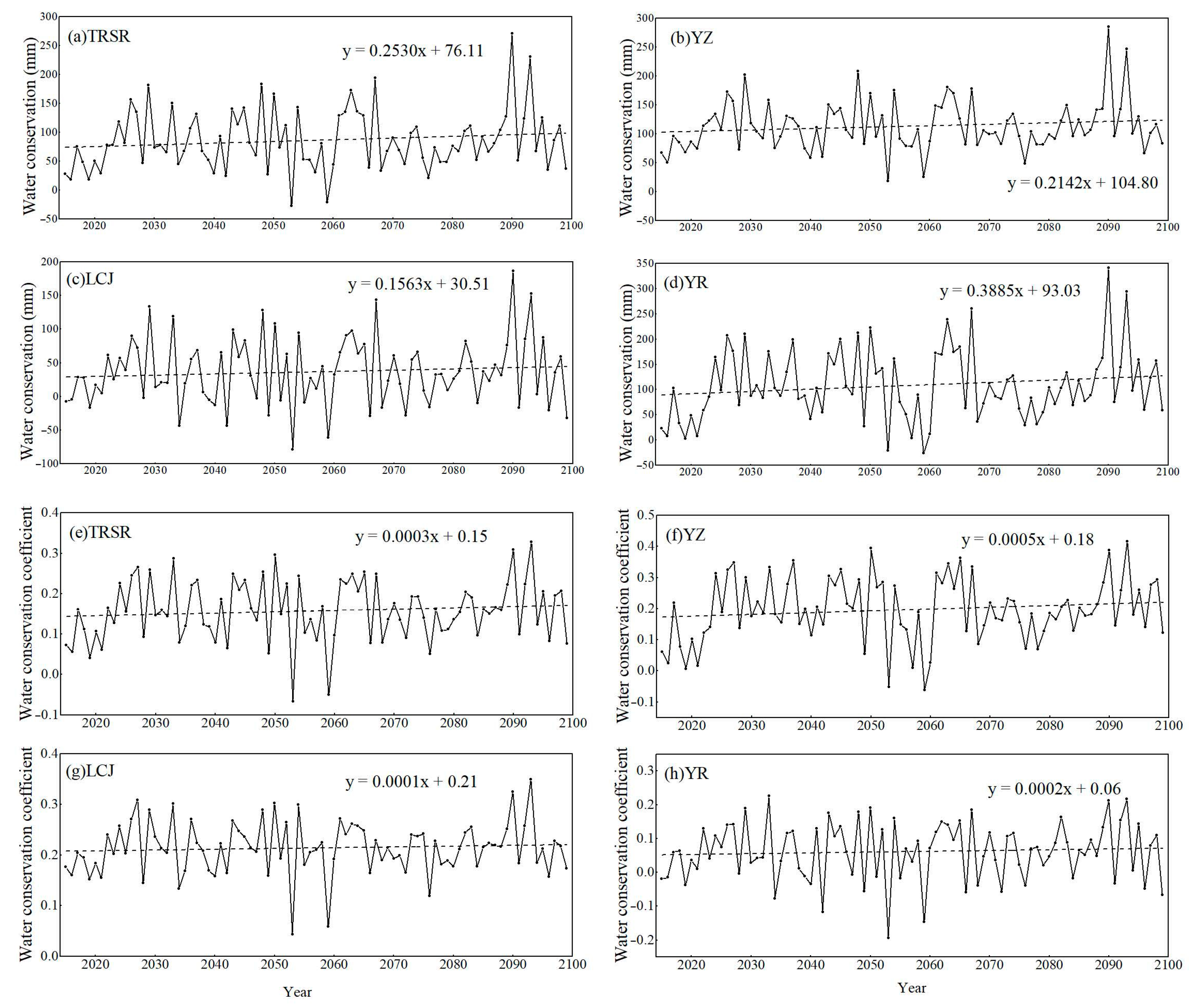

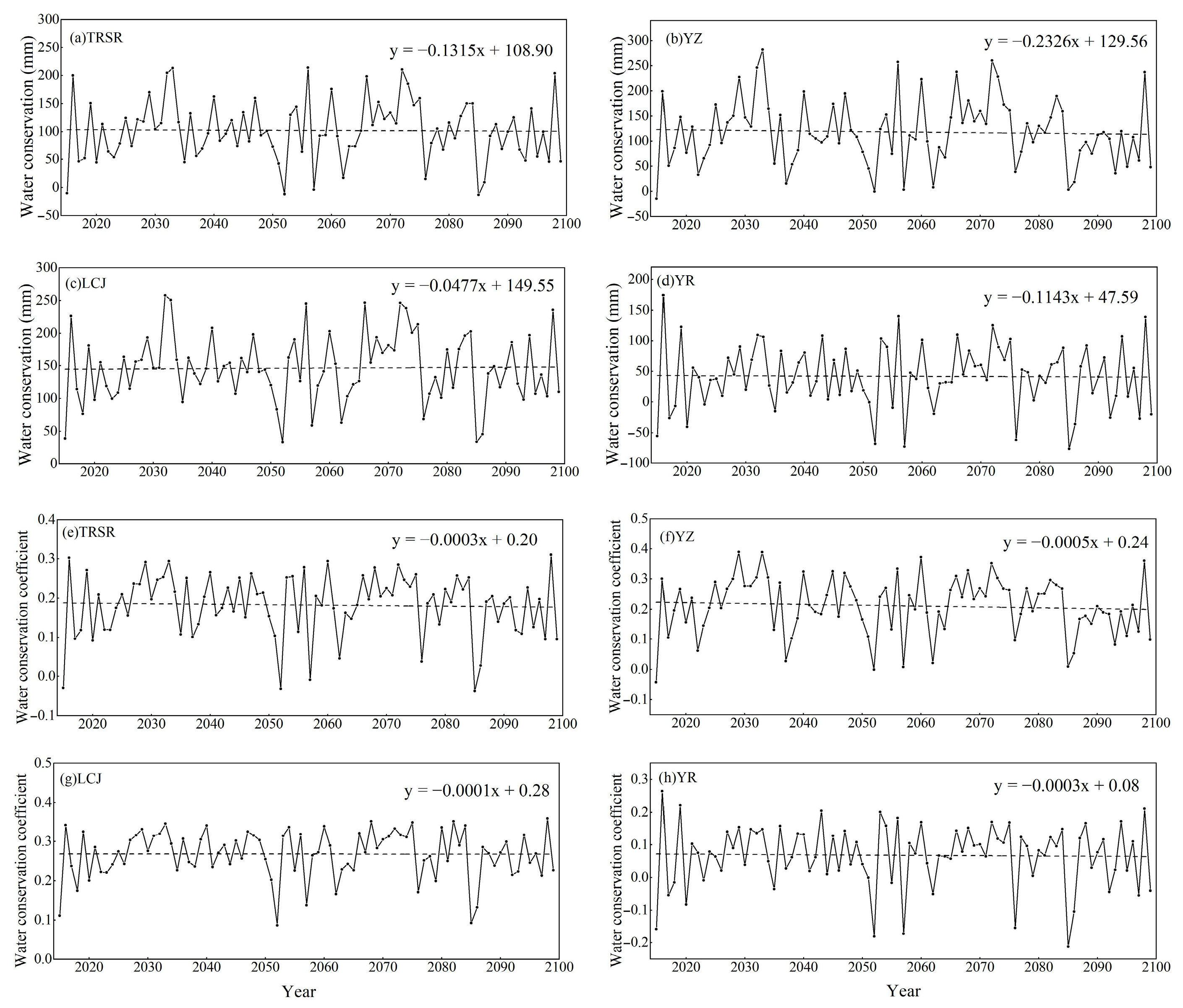
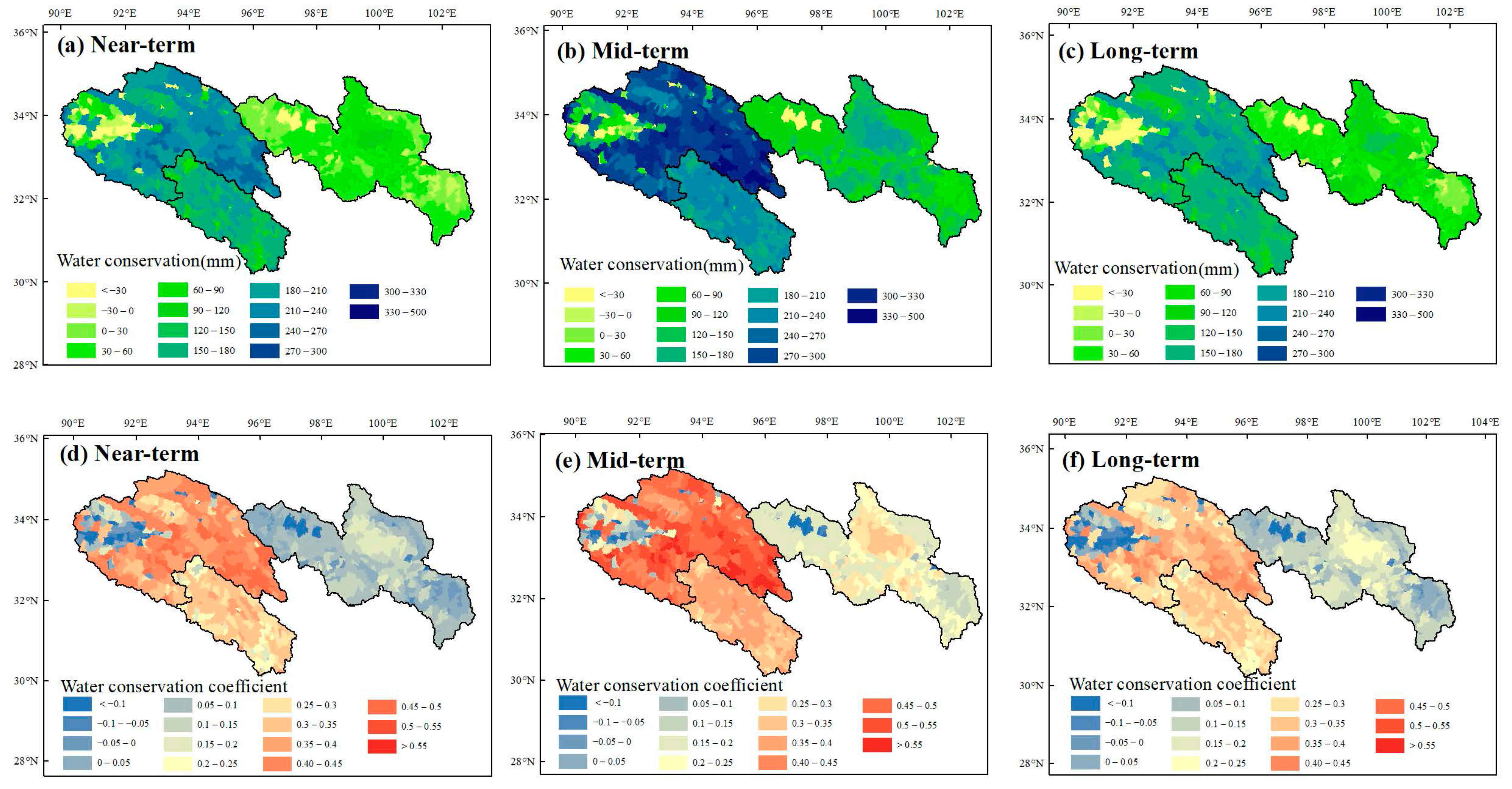
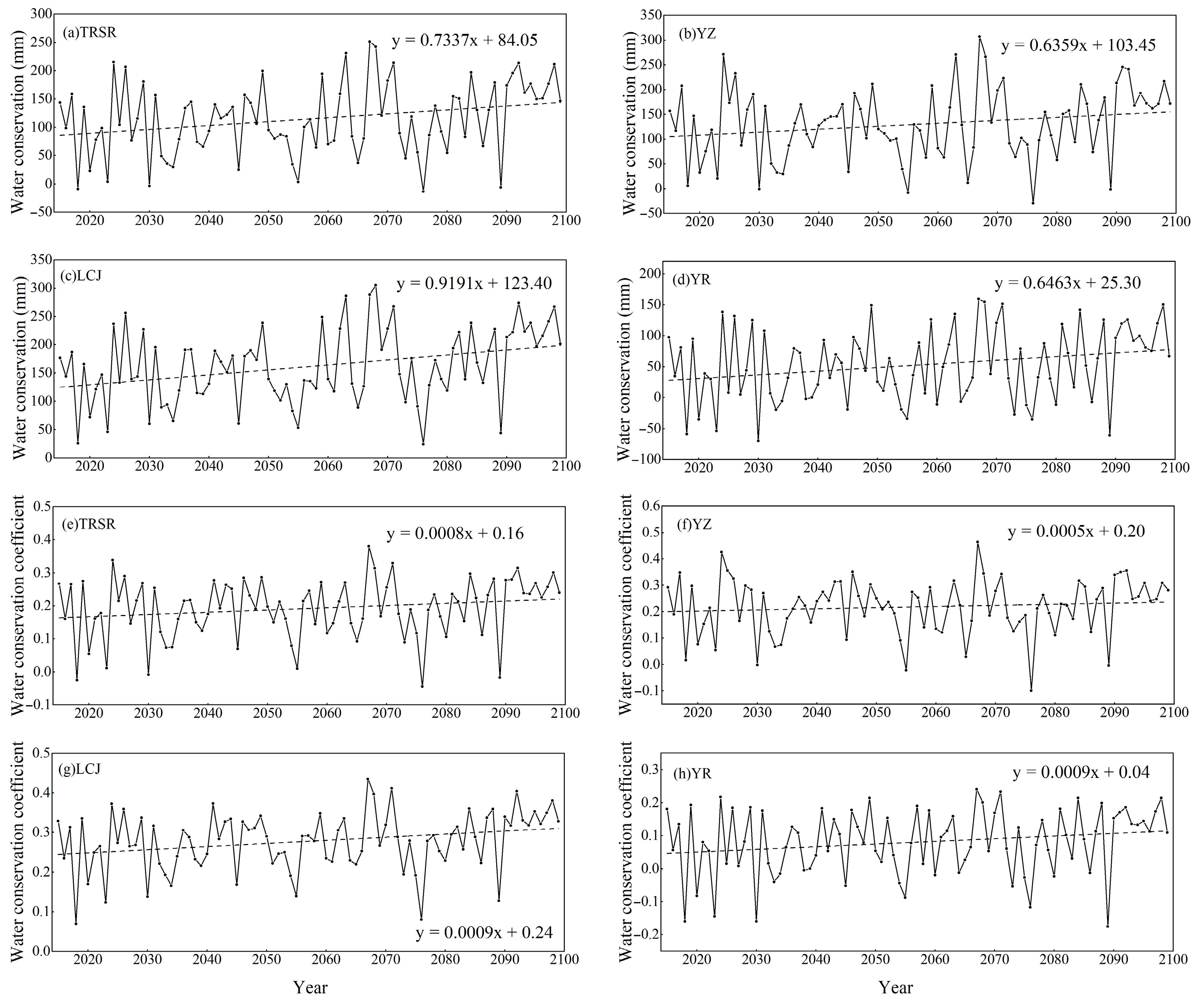

| Station ID | Station Name | Longitude | Latitude | Data Range |
|---|---|---|---|---|
| 40100350 | Tangnaihai | 100.15 | 35.5 | 1 January 1981 to 1 December 2019 |
| 60100700 | Zhimenda | 97.25 | 32.99 | 1 January 1981 to 15 September 2019 |
| 90200100 | Changdu | 97.18 | 31.18 | 15 January 1981 to 15 December 2009 |
| Water Conservation Capacity (mm/Year) | Water Conservation Coefficient | |||||
|---|---|---|---|---|---|---|
| Near-Term | Mid-Term | Long-Term | Near-Term | Mid-Term | Long-Term | |
| Three-River Source Region (TRSR) | 1.4091 | −0.1089 | 2.2681 | 0.0024 | −0.0002 | 0.0025 |
| Yangtze River Source (YZ) | 0.838 | −0.1695 | 1.7663 | 0.0054 | −0.0005 | 0.0054 |
| Lancangjing River Source (LCJ) | 0.5994 | 0.1004 | 1.1168 | 0.001 | −0.0003 | 0.0011 |
| Yellow River Source (YR) | 2.7897 | −0.2576 | 3.9212 | 0.0008 | 0.0003 | 0.001 |
| Water Conservation Capacity (mm/Year) | Water Conservation Coefficient | |||||
|---|---|---|---|---|---|---|
| Near-Term | Mid-Term | Long-Term | Near-Term | Mid-Term | Long-Term | |
| TRSR | 1.0066 | 2.217 | −0.0854 | 0.002 | 0.002 | −0.0007 |
| YZ | 1.0751 | 2.7391 | −2.7437 | 0.002 | 0.0025 | −0.0032 |
| LCJ | 1.1682 | 2.3827 | −2.3749 | 0.0019 | 0.0015 | −0.002 |
| YR | 0.7764 | 1.5293 | −0.6127 | 0.0021 | 0.0021 | −0.0021 |
| Water Conservation Capacity (mm/Year) | Water Conservation Coefficient | |||||
|---|---|---|---|---|---|---|
| Near-Term | Mid-Term | Long-Term | Near-Term | Mid-Term | Long-Term | |
| TRSR | 0.3165 | 1.768 | 4.9839 | 0.001 | 0.0012 | 0.0064 |
| YZ | 0.2147 | 1.5756 | 5.2828 | 0.0008 | 0.0006 | 0.0068 |
| LCJ | 0.6318 | 2.4682 | 5.6528 | 0.0014 | 0.0017 | 0.0061 |
| YR | 0.103 | 1.26 | 4.0161 | 0.0009 | 0.0014 | 0.0061 |
Disclaimer/Publisher’s Note: The statements, opinions and data contained in all publications are solely those of the individual author(s) and contributor(s) and not of MDPI and/or the editor(s). MDPI and/or the editor(s) disclaim responsibility for any injury to people or property resulting from any ideas, methods, instructions or products referred to in the content. |
© 2024 by the authors. Licensee MDPI, Basel, Switzerland. This article is an open access article distributed under the terms and conditions of the Creative Commons Attribution (CC BY) license (https://creativecommons.org/licenses/by/4.0/).
Share and Cite
Liu, Z.; Di, Z.; Zhang, W.; Sun, H.; Tian, X.; Meng, H.; Liu, J. The Historical and Future Variations of Water Conservation in the Three-River Source Region (TRSR) Based on the Soil and Water Assessment Tool Model. Atmosphere 2024, 15, 889. https://doi.org/10.3390/atmos15080889
Liu Z, Di Z, Zhang W, Sun H, Tian X, Meng H, Liu J. The Historical and Future Variations of Water Conservation in the Three-River Source Region (TRSR) Based on the Soil and Water Assessment Tool Model. Atmosphere. 2024; 15(8):889. https://doi.org/10.3390/atmos15080889
Chicago/Turabian StyleLiu, Zhenwei, Zhenhua Di, Wenjuan Zhang, Huiying Sun, Xinling Tian, Hao Meng, and Jianguo Liu. 2024. "The Historical and Future Variations of Water Conservation in the Three-River Source Region (TRSR) Based on the Soil and Water Assessment Tool Model" Atmosphere 15, no. 8: 889. https://doi.org/10.3390/atmos15080889





